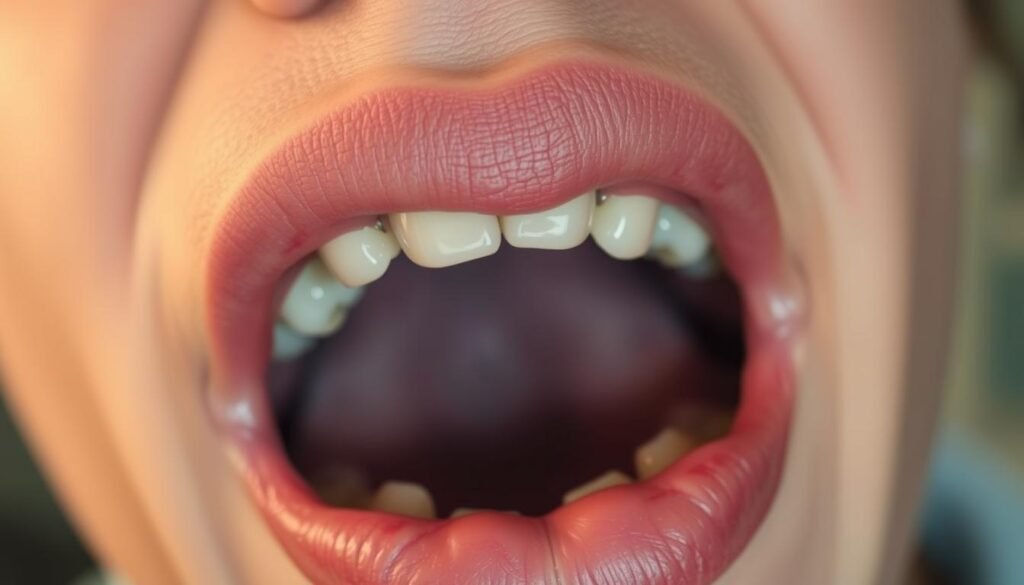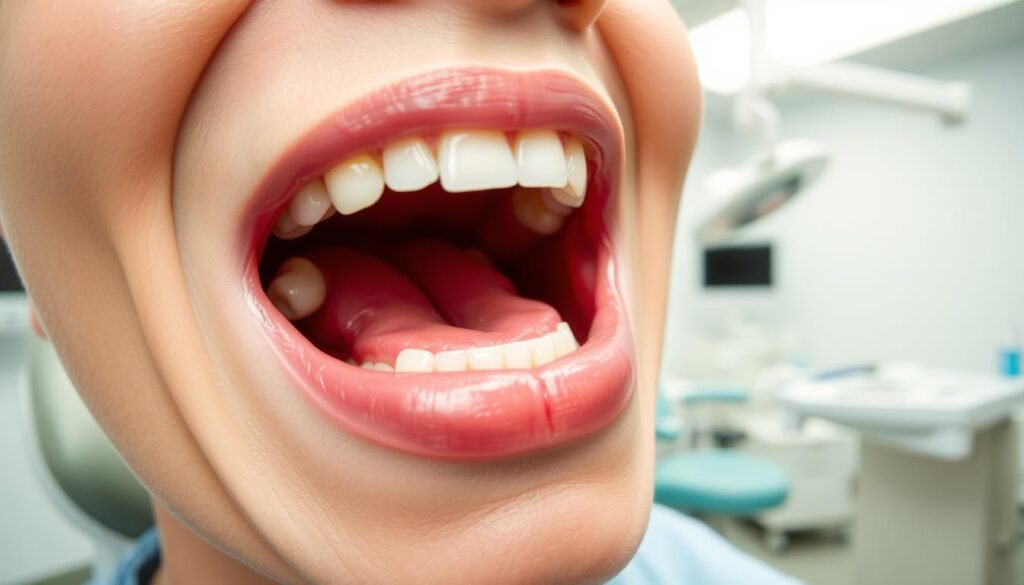After a tooth extraction, many patients wonder about how long for stitches to dissolve. Most tooth extraction stitches are designed to disappear on their own, usually within 2 to 7 days. This timeframe can vary based on the type of suture material used and the specifics of your procedure.
Key Takeaways
- Tooth extraction stitches typically dissolve within 2–7 days.
- Some sutures may take up to two weeks to fully break down.
- Proper aftercare speeds up healing and reduces infection risk.
- Swelling or discomfort after extraction is normal during recovery.
- Always follow your dentist’s post-op instructions for best results.
Your dentist chooses stitches based on your mouth’s needs. While waiting for them to dissolve, avoid tugging at the area or using sharp objects to check progress. If you notice unusual swelling, bleeding, or pain beyond a week, contact your dental provider immediately.
Understanding Tooth Extraction and Healing
Knowing what to expect during a tooth extraction and how your body heals can ease concerns about the process. This section covers the procedure itself and the first steps of recovery.
What Happens During a Tooth Extraction?
Here’s what typically occurs during the procedure:
- A local anesthetic numbs the area to ensure comfort.
- The dentist gently rocks the tooth out or makes a small incision for complex cases.
- The socket is cleaned, and stitches may be placed to close the wound.
The Natural Healing Process Explained
Aftercare focuses on supporting your body’s oral surgery recovery. Key phases include:
- Formation of a blood clot in the socket to protect nerves and encourage healing.
- Swelling and minor bleeding in the first 24–48 hours.
- New gum and bone tissue rebuilding over weeks.
Follow post-op instructions to avoid disrupting clots, which are vital for tooth extraction healing. Mild discomfort is normal, but severe pain or prolonged bleeding warrant a dentist’s review.
Timeline for Stitches Dissolving
After a tooth extraction, the stitch dissolution time varies but typically falls between 2–7 days. Most patients notice stitches softening within a few days, with complete disappearance by the end of the first week. However, some cases may take up to two weeks, depending on the suture type and extraction location.
- Standard stitches often dissolve within 5–7 days.
- Heavy-duty sutures, used for complex procedures, may last 10–14 days.
- Front teeth extractions heal faster than molars due to less tension in the gum tissue.
A dentist’s choice of material directly impacts the stitch dissolution time. For example, fast-absorbing gut sutures break down quicker than polyglycolic acid options. Always follow post-op instructions to avoid premature suture disruption.
“Monitor stitches daily but avoid touching them,” advises Dr. Emily Carter, a periodontist in Texas. “An uneven bite or persistent pain could signal delayed healing.”
If stitches remain intact beyond two weeks or cause swelling, contact your dentist. Individual health factors like diabetes or smoking can extend the timeline. Keep the area clean to prevent infection, which might delay natural stitch dissolution time. Regular checkups ensure any complications are addressed early, keeping recovery on track.
how long for stitches to dissolve after tooth extraction
Stitches after a tooth extraction don’t last forever. Knowing when they’ll dissolve helps you track recovery. Proper post extraction care ensures stitches break down smoothly without infection.

Expected Duration of Dissolution
Most dissolvable stitches fade within 7 to 10 days. Simple procedures often finish dissolving by day 10. Surgical cases like wisdom teeth may take 14–21 days. Always follow your dentist’s advice for checkups.
Differences Based on Extraction Techniques
Simple extractions use thinner sutures that dissolve faster. Surgical methods require stronger stitches. Materials matter too:
- Polyglactin: Breaks down in 7–14 days.
- Nylon: May need removal by a dentist.
Complex surgeries, like impacted teeth removal, need longer-lasting stitches. Follow post extraction care steps to avoid delays. Ask your dentist about your suture type and aftercare steps.
Factors That Affect Dissolution Time
Several factors influence how quickly dissolvable stitches dissolve after a tooth extraction. These variables range from the type of suture material to your overall health and aftercare practices.
- Suture Material: Absorbable materials like polyglycolic acid dissolve in 7–14 days, while non-absorbable options like nylon require manual removal.
- Healing Environment: Moist oral tissues accelerate dissolution compared to drier areas. Poor oral hygiene slows the process by fostering bacterial growth.
- Health Conditions: Diabetes or weakened immunity can delay healing, extending suture dissolution time.
- Age: Younger patients typically heal faster due to better tissue regeneration.
“Nylon sutures provided the best biological results for dental socket healing, while silk delayed recovery,” according to a histological study on suture materials.
| Suture Type | Material Type | Dissolution Time | Infection Risk |
|---|---|---|---|
| Nylon | Non-absorbable | Does not dissolve | Low (if removed timely) |
| Polyglycolic Acid | Resorbable | 7–14 days | Minimal |
| Silk | Non-absorbable | Manual removal needed | High (due to biofilm formation) |
| Vicryl Plus | Resorbable | 10–21 days | Low (triclosan coating reduces bacteria) |
Materials like dissolvable stitches coated with triclosan (e.g., Vicryl Plus) reduce bacterial growth, speeding up recovery. Always discuss material choices with your dentist to align with your health profile.
Step-by-Step Post-Extraction Care
Proper oral surgery aftercare ensures your recovery stays on track. Follow these steps to protect the extraction site and reduce risks.
Immediate Aftercare Instructions
- Bite gently on the gauze provided for 30–45 minutes to stabilize blood clot formation. Replace gauze only if bleeding continues.
- Apply an ice pack to the cheek for 15–20 minutes every hour during the first 24–48 hours to reduce swelling.
- Avoid rinsing, spitting, or drinking through a straw for at least 24 hours to prevent clot disruption.
Safety and Recovery Guidelines
- Rest for the first 24 hours. Avoid exercise, lifting heavy objects, or bending excessively.
- After 12 hours, rinse gently with warm salt water (½ teaspoon salt in 8 oz warm water) four times daily.
- Eat soft foods like yogurt, applesauce, or mashed potatoes for the first 48 hours. Avoid hard, crunchy, or sticky items.
- Do not smoke or drink alcohol for 72 hours to avoid delaying healing.
- Contact your dentist if bleeding lasts over 2 hours, swelling worsens after 48 hours, or fever develops.
Stick to these guidelines to lower the risk of dry socket or infection. Prioritize rest and gentle oral hygiene to support recovery.
Recognizing Signs of Proper Healing
After a tooth extraction, knowing the oral surgery recovery milestones helps ensure you’re on the right track. A smooth healing process often shows up as visible improvements. Look for these positive signs:
- Reduced swelling: Swelling should fade within a few days, with less puffiness around the mouth.
- Less pain: Mild discomfort is normal, but sharp or worsening pain may signal an issue.
- Minimal bleeding: Bleeding should stop within 24 hours. A clean extraction site means healing is progressing.
- Improved function: Gradual return to soft foods and normal mouth movements.

Maintaining good oral hygiene during oral surgery recovery speeds healing. Rinse gently with saltwater to keep the area clean. If swelling stays down and discomfort lessens daily, your body is healing as expected. Always brush carefully around the site to avoid disrupting stitches.
Trust your body’s signals. A healing site that feels calmer and looks cleaner each day means you’re moving toward full recovery. Stay patient—your body works hard to repair itself after oral surgery!
Common Complications and When to Seek Help
Most recoveries go smoothly, but tooth extraction complications can arise. Knowing the warning signs helps you act quickly to prevent further issues.
- Severe Pain: Intense discomfort days after extraction, especially if radiating to the ear, eye, temple, or neck, may signal dry socket.
- Excessive Bleeding: Ongoing bleeding beyond 24 hours or clots dislodging require urgent care.
- Infection Signs: Fever, swelling, or pus at the site indicate possible infection.
“Persistent pain beyond typical healing timelines should never be ignored,” advise dental experts. Dry socket, a common complication, leaves bone exposed and needs prompt treatment.
If you notice tooth extraction complications like these, contact your dentist immediately. Early intervention reduces risks like infection spread or prolonged healing. Always follow post-op instructions to minimize chances of these issues.
Expert Tips for a Smooth Recovery
Recovering after a tooth extraction requires mindful care to protect dental stitches and encourage healing. Follow these simple steps to avoid setbacks and feel better faster.
Dos and Don’ts During Recovery
- Do stick to soft foods like yogurt or applesauce to avoid straining dental stitches.
- Don’t smoke or drink through straws, as suction can dislodge stitches.
- Do gently rinse with warm salt water 24 hours post-surgery to keep the area clean.
- Don’t touch stitches with fingers or tools—let them dissolve naturally.
Lifestyle Adjustments to Promote Healing
Making small changes speeds up recovery:
- Rest: Limit physical activity for 48 hours to prevent bleeding and protect stitches.
- Hydrate wisely: Drink water carefully, avoiding hot liquids that could irritate stitches.
- Clean gently: Brush teeth carefully, avoiding the extraction site to keep stitches intact.
Avoid spicy or crunchy foods that might disrupt stitches. Opt for nutrient-rich meals to fuel healing.
Conclusion
Recovering from a tooth extraction involves patience and proper care, but knowing what to expect can ease your mind. The stitch dissolution time varies, with most absorbable stitches disappearing within 7–10 days. Following post extraction care steps ensures your mouth heals smoothly without complications.
Healing timelines depend on factors like the extraction complexity and your overall health. Prioritize rest, gentle oral hygiene, and sticking to post extraction care guidelines. These steps create the best environment for stitches to dissolve naturally.
If swelling, pain, or bleeding worsen after a few days, contact your dentist immediately. Early intervention prevents minor issues from becoming serious. Keep all follow-up appointments to monitor progress and address concerns promptly.
Trust the process and let your body recover at its own pace. By adhering to your dentist’s instructions and staying alert to warning signs, you’ll support your mouth’s natural healing journey effectively.




